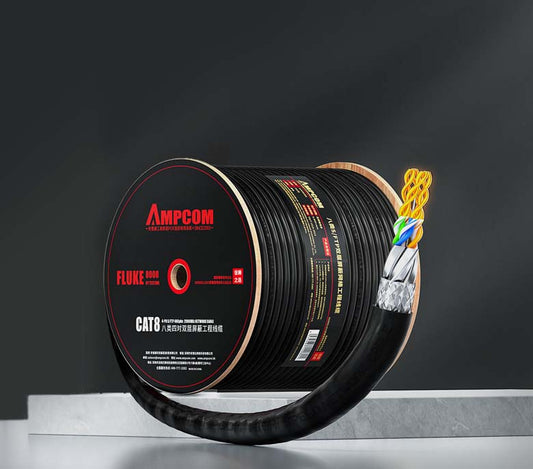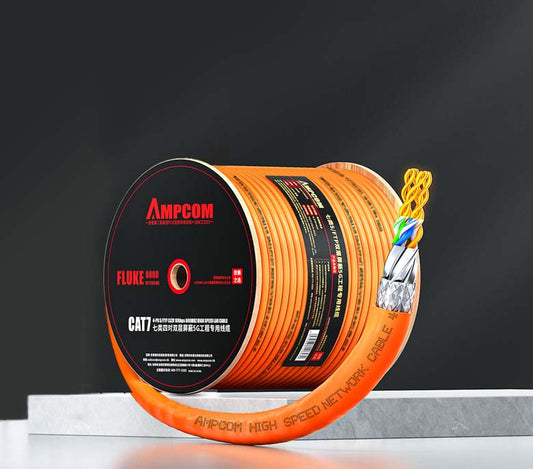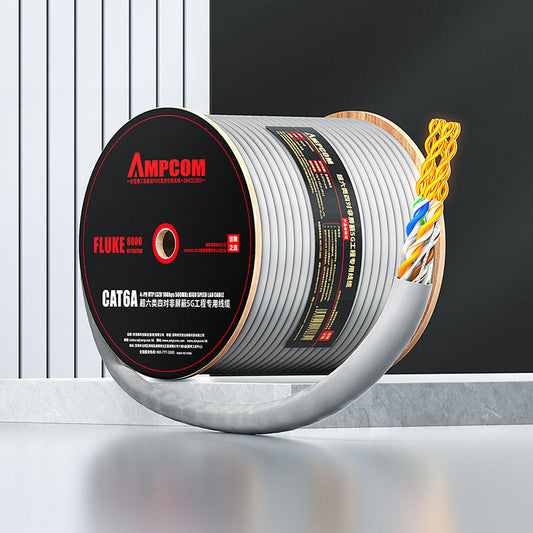The Performance & Speed Ladder: How to Precisely Choose Cable Category Based on Network Needs
Introduction
In the context of today's global digital wave, the network has become the cornerstone supporting everything from personal life and business operations to the functioning of society as a whole. From home entertainment to multinational corporate collaboration, from smart homes to industrial IoT, the ubiquitous demand for network connectivity places unprecedented high requirements on the speed, stability, and reliability of data transmission. And when building and maintaining these network infrastructures, a seemingly insignificant yet critically important component— network patch cable —plays an indispensable role. The common network patch cable categories found in the market, such as Cat5e, Cat6, Cat6a, Cat7, and Cat8, are like steps on a ladder of performance and speed, each capable of handling different levels of transmission capacity. So, faced with a wide array of choices, how do we precisely select the most suitable cable category based on actual network needs? This article will delve into the performance differences between these cable categories and, combined with different application scenarios, provide you with a detailed selection guide.

1. The Basics of Network Cables: Understanding the Meaning of "Category"
Before delving deeper into the various cable categories, we first need to understand the concept of "Category" (often abbreviated as "Cat"). The category of network patch cables is defined and certified by relevant standards organizations (such as TIA/EIA in the US or ISO/IEC internationally) based on the transmission performance parameters of the cable at specific frequencies (such as attenuation, near-end crosstalk, return loss, etc.). These standards ensure that patch cables of the same category produced by different manufacturers are interchangeable and offer predictable performance. Generally, a higher category number means the cable can support higher transmission frequencies, has better resistance to interference, and can therefore carry faster network signals.
It's important to note that the category of a patch cable is only one part of the performance of the entire network link (which includes components like patch panels, switch ports, and connectors). The ultimate performance grade of a network link is determined by the component with the lowest performance within it. Therefore, when selecting a patch cable, it's not only necessary to consider the category of the cable itself but also to ensure that other supporting facilitiescomponents (especially connectors) meet or exceed the category standard of the selected patch cable.
2. In-Depth Analysis of Various Cable Categories: Performance Parameters and Capability Boundaries
Let's analyze each of the five mainstream patch cable categories, from Cat5e Patch Cable to Cat8 Patch Cable, to understand their respective technical specifications and applicable ranges.
1. Cat5e (Enhanced Category 5): Entry-Level High-Speed Choice
Frequency: 100 MHz
Maximum Speed: 1 Gbps (Gigabit Ethernet)
Transmission Distance: Typically 100 meters (for 1 Gbps speed)
Structure: Usually consists of four pairs of 24 AWG (American Wire Gauge) copper conductors, using twisted pair technology to reduce electromagnetic interference.
Cat5e is an enhanced version of Cat5, with the main improvement being increased performance margins for near-end crosstalk (NEXT) and return loss (Return Loss), allowing it to reliably support 1 Gbps transmission speeds.
Features and Limitations:
Pros: Relatively low cost; was the mainstream choice during the early days of Gigabit Ethernet adoption; still has applications in scenarios with limited budgets and relatively low network demands.
Cons: Does not support 10 Gbps speeds (unless under specific conditions, such as extremely short distances and minimal environmental interference, but performance cannot be guaranteed); relatively weaker resistance to interference; signal quality may degrade in environments with strong electromagnetic interference.
Applicable Scenarios:
Home Networks: For users who only need to meet basic internet browsing, streaming media playback (like 720p/1080p), and standard office tasks, Cat5e is usually sufficient.
Small Offices: For SOHO (Small Office/Home Office) environments with a small number of employees and relatively simple network applications, Cat5e can meet basic network connectivity needs.
Upgrading Existing Cat5e Wiring: If a building already has Cat5e wiring deployed and there is no urgent need for 10 Gbps speeds, Cat5e patch cables can still be used.
2. Cat6 (Category 6): Mainstream Gigabit and Limited 10 Gigabit Choice
Frequency: 250 MHz (2.5 times Cat5e)
Maximum Speed:
1 Gbps: Up to 100 meters
10 Gbps: Typically only supports up to 55 meters (official standards specify between 37-55 meters, with 55 meters being a common practical upper limit)
Structure: Similar to Cat5e, it also uses four pairs of 24 AWG copper conductors, but typically includes a central cross-piece (spine) separating the four pairs of cables to further reduce crosstalk between pairs, thereby improving performance. A higher frequency means stronger resistance to interference and lower signal attenuation.
Features and Advantages:
Pros: Compared to Cat5e, it offers better performance margins, allowing for more stable support of 1 Gbps speeds, and can support 10 Gbps speeds over shorter distances (e.g., short connections within data center racks).
The cross-piece design helps improve the cable's geometric structure and reduces performance impacts during installation.
Cons: Performance cannot be guaranteed when running 10 Gbps over long distances (exceeding 55 meters).
Slightly higher cost than Cat5e.
From "Chaos" to "Order": The Importance and Best Practices of Data Center Cable Management
Applicable Scenarios:
Small and Medium Enterprises: For environments requiring stable Gigabit networks and potentially upgrading to 10 Gbps in the next few years (especially for short-distance applications like server-to-switch connections), Cat6 is a cost-effective choice.
Home Network Upgrades: For home users seeking a more stable Gigabit experience or planning to upgrade short-distance connections (e.g., router to high-performance NAS) to support 10 Gbps in the future.
Educational Institutions: Many schools choose Cat6 when updating their networks to balance performance and cost.
3. Cat6a (Augmented Category 6): Reliable Choice for Full-Duplex 10 Gigabit
Frequency: 500 MHz (twice Cat6)
Maximum Speed: 10 Gbps, up to 100 meters
Structure: To maintain performance at the higher frequency of 500 MHz, Cat6a cables typically use thicker conductors (e.g., 23 AWG), have pairs twisted more tightly, and may use more robust central cross-pieces or fillers internally to further isolate pairs and reduce crosstalk. Their physical size is usually larger than Cat6.
Features and Advantages:
Pros: First achieved stable support for full-duplex 10 Gbps Ethernet over the standard 100-meter distance.
Stronger resistance to interference and lower attenuation allow it to perform better in complex electromagnetic environments.
Cons: Significantly higher cost than Cat6 and Cat5e.
The thicker cable may impose higher requirements on conduit and space.
Connectors may also require more space.
Applicable Scenarios:
Medium and Large Enterprises: For businesses requiring widespread deployment of 10 Gbps networks, covering entire office areas, with high demands for network performance and stability.
Data Centers (Early 10Gbps Deployments): In the early days of 10 Gbps Ethernet adoption, Cat6a was the mainstream choice for connections between servers, storage, and switches within data centers.
Industrial Environments: In industrial control or manufacturing environments with strong electromagnetic interference, Cat6a's strong resistance to interference makes it a more reliable choice.
4. Cat7 (Category 7): Shielding is King, Guarding High-Speed Rates
Frequency: 600 MHz
Maximum Speed:
10 Gbps, up to 100 meters (using GG45 connectors defined by ISO/IEC 24702 standard or TeraLink® connectors defined by TIA TSB-155 standard);
Can also support 40 Gbps (within 25 meters, using specific connectors like ARJ45).
Structure: The most significant feature of Cat7 is its fully shielded design. It not only contains four pairs of twisted wires, with each pair having a foil shield (FTP - Foiled Twisted Pair or S/FTP), but the entire bundle of four pairs is also wrapped in an outer overall foil shield (OFP). This dual-shielding design greatly enhances resistance to external electromagnetic interference (EMI) and prevents internal signal radiation from interfering with other devices. Cat7 typically uses thicker 23 AWG conductors.
Features and Advantages:
Pros: Extremely strong resistance to interference, suitable for very demanding electromagnetic environments.
Supports frequencies up to 600 MHz, reserving space for future higher-speed networks (like 40 Gbps short-range).
Provides very high signal integrity and reliability.
Cons: Very high cost.
Its unique shielding structure requires that connectors must also be shielded types, and installation requires very high craftsmanship; the shielding layers must be properly grounded, otherwise the shielding effect will be significantly reduced or even introduce noise.
Both the cable and connectors are larger, increasing installation difficulty and space occupation.
Cat7 is not part of the TIA/EIA standards but is defined as an amendment to the European standard ISO/IEC 11801.
Investment vs. Return: Evaluating the Value of Cat7/Cat8 Cables in Data Centers and HPC
Applicable Scenarios:
High-Demand Data Centers: For early 40 Gbps deployments requiring extreme signal integrity and interference resistance, or data centers located near strong electromagnetic interference sources.
Severe Industrial Environments: Such as power, manufacturing, etc., where there are a large number of heavy electrical equipment or high-frequency devices.
Research Institutions: Laboratory environments requiring extremely high reliability and low interference.
Scenarios requiring backward compatibility with 10 GBase-T: Although Cat6a can also support 10 Gbps, in environments with severe interference, Cat7 provides a safer choice.
5. Cat8 (Category 8): Pioneering the Way to 40G/100G
Frequency: 2000 MHz (2 GHz)
Maximum Speed: 25 Gbps / 40 Gbps
Transmission Distance: 25 meters or 50 meters (depending on speed and specific standard)
Structure: Cat8 patch cables typically use thicker conductors (e.g., 23 AWG) and may employ a central cross-piece design to optimize pair isolation. To achieve extremely high frequencies and speeds, their shielding design is also usually very stringent, commonly S/FTP (shielded individual pairs + overall shield) or SSTP (shielded twisted pairs + overall shield). Cat8 patch cables are designed more for short-distance, high-density connections.
Features and Advantages:
Pros: Capable of supporting one of the current fastest Ethernet standards (25G/40G), meeting the extremely high bandwidth demands of applications like high-performance computing, AI training, and high-speed interconnects within large-scale data centers.
Extremely high frequency brings greater potential for resistance to interference.
Cons: Highest cost.
Transmission distance is limited to 25 or 50 meters, primarily used for short-distance connections within data centers, not suitable for long-distance cabling.
Requires very high standards for installation and maintenance.
Cat8 is a relatively new standard (TIA-568.2-D), and its ecosystem is still developing.
Applicable Scenarios:
High-Performance Computing (HPC) Centers: Connecting high-performance servers, storage arrays, and high-speed network switches.
Large Cloud Data Centers: Used for 40Gbps/25Gbps high-speed connections within server racks or between racks to support virtualization, containerization, and large-scale data processing.
AI and Machine Learning Platforms: These applications generate and consume massive amounts of data, requiring extremely high network bandwidth.
Financial Trading: Requires network connections with extremely low latency and high throughput.

3. How to Choose Precisely: A Needs-Driven Decision Framework
Having understood the performance differences between the various cable categories, the key to selection lies in "precise matching." Here is a decision framework based on network needs:
Identify current and near-future network applications:
Basic Applications: Web browsing, email, document processing, standard HD video streaming (e.g., 1080p). -> Cat5e is usually sufficient.
Advanced Applications: 4K/8K video streaming, online gaming, large file transfers, entry-level VDI (Virtual Desktop Infrastructure). -> Cat6 is a reliable choice; Cat5e might become a bottleneck.
High-Performance Applications: Virtualization, cloud computing, large database access, complex design/rendering, multi-person HD video conferencing, internal data center connections. -> Cat6a is the mainstream; Cat7/Cat8 apply to specific high-performance scenarios.
Ultimate Performance Applications: HPC, AI training, large-scale data centers, ultra-low latency trading. -> Cat8 is the current mainstream choice; Cat7 might be used for 40Gbps in specific interference environments.
Determine the required network speed and transmission distance:
1 Gbps, 100 meters: Cat5e, Cat6, Cat6a are all possible; Cat6a offers the most stable performance.
10 Gbps, 100 meters: Cat6a is the standard choice; Cat7 can also be used; Cat6 is limited to within 55 meters.
10 Gbps, severe interference environment: Cat7 is a safer choice.
25 Gbps / 40 Gbps, 25/50 meters: Cat8 is the only standard-compliant choice.
Assess environmental factors:
Electromagnetic Interference (EMI) Level: If the environment contains many strong interference sources like motors, inverters, radio equipment, etc., it's best to prioritize categories with better shielding performance, such as Cat7 or Cat6a (Cat6a also has shielded versions S/FTP). The unshielded versions (UTP) of Cat5e and Cat6 will see significantly degraded performance under strong interference.
Physical Space and Conduit: Cat6a, Cat7, Cat8 are typically thicker than Cat5e/Cat6 and require confirmation that existing conduits have sufficient space.
Perform a cost-benefit analysis:
Initial Cost: Cat5e < Cat6 < Cat6a < Cat7 < Cat8. The cost of patch cables and connectors increases at each level.
Long-Term Cost: Consider the convenience and cost of future upgrades. Selecting a category that can meet your needs for the next 3-5 years can prevent premature rewiring. For example, deploying Cat6a or Cat7 in a new data center might be more economical than upgrading from Cat5e/Cat6 to Cat6a several years later.
Consider compatibility and standardization:
Ensure the selected cable category is compatible with network equipment (switch ports, NICs).
Prefer categories that comply with mainstream standards (TIA/EIA or ISO/IEC).
Cat7 and Cat8 have some different connector standards; ensure end-to-end compatibility.

4. Common Misconceptions and Precautions
Misconception 1: More expensive is always better; blindly chasing higher categories. Not every scenario requires Cat7 or Cat8. Using Cat8 in a scenario with only Gigabit needs is not only extremely expensive but may also cause installation difficulties due to the cable's thickness. "Good enough" is the basic principle.
Misconception 2: Ignoring connectors and termination craftsmanship. No matter how good the patch cable's performance is, if the connectors are of poor quality or the termination (wiring) craftsmanship is non-standard, the performance of the entire link will be significantly degraded. Choose high-quality connectors and ensure professional installation.
Misconception 3: Ignoring the proper grounding of shielded cables. For shielded patch cables like Cat7 and above, proper grounding is crucial. The shielding layer must be reliably connected to the grounding system of the patch panel and equipment via the connector; otherwise, it will not only fail to provide shielding but may also introduce noise.
Precautions: When upgrading or building a new network, it's best to plan the cable category uniformly to avoid mixing different categories of patch cables within the same network, which can cause confusion in management and performance.
Conclusion
Network patch cables from Cat5e to Cat8 form a ladder of performance and speed, with each step representing different transmission capabilities and application scenarios. From home offices to large data centers, from meeting basic needs to pursuing ultimate performance, choosing the right cable category is the foundation for building an efficient, stable, and reliable network. By deeply understanding the technical specifications and performance boundaries of each category, and comprehensively evaluating your own network needs, budget, and environmental factors, we can find the most suitable step on this ladder, precisely paving the way to an efficient network. Remember, network construction is a long-term investment. Finding the best balance point between performance, cost, and future scalability is a wise choice.



